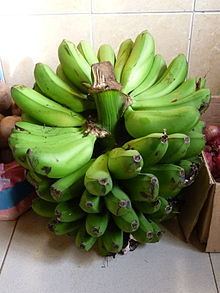Origin Uganda Species Musa acuminata | Cultivar group members See text | |
 | ||
Cultivar group Musa acuminata (AAA-EA) or the Mutika/Lujugira subgroup of the AAA Group Similar Musa acuminata, Cosmopolites sordidus, Rhino Horn bananas, Radopholus similis, Karat banana | ||
East African Highland bananas (EAHB) are triploid banana cultivars originating from the African Great Lakes region. They are a staple food crop in Uganda and other Great Lakes countries, and are used to make matoke.
Contents
East African Highland bananas are also known as the Mutika/Lujugira subgroup.
Description
East African Highland bananas are easily distinguishable from other banana cultivars by the numerous black (or more rarely brown or bronze) blotches on their pseudostems, giving them the appearance of polished metal. The outermost sheath of their pseudostems are a medium green, superimposed over the pink to purple underlying sheaths.
Their leaves are also darker green and dull, a difference more apparent when comparing them side by side with other banana cultivars from a distance.
The inflorescence has peduncles covered with coarse hair. The bracts are ovate to lanceolate in shape with outer surfaces that are purple to brown and inner surfaces which are red fading to yellow towards the base. The male flowers have cream colored tepals with yellow lobes. The anthers are pink while the stigma are orange.
The fruits are recurved and can vary in length. They are inflated with blunt tips. The pulp is white in unripe fruits and cream-colored in ripe fruits.
Taxonomy
East African Highland bananas are triploid (AAA) cultivars. Their official designation is Musa acuminata Colla (AAA-EA). Synonyms include Musa brieyi De Wild. Their paternal parent is the blood banana subspecies (M. acuminata ssp. zebrina) of the wild banana species Musa acuminata.
East African Highland bananas are a subgroup which refers to about 200 individual banana cultivars (or clones). They can be subdivided into five distinct groups of clones known as clone sets:
Over 500 local names are known for cultivars from the EAHB subgroup.
Origin and distribution
East African Highland bananas were introduced early into Africa from Southeast Asia during the first to sixth centuries AD, probably via trade. They are genetically distinct from the other AAA cultivars, having evolved locally in the African Great Lakes region for over a millennium. They are found nowhere else in the world, and the African Great Lakes has been called the secondary center of banana diversity because of this (with Southeast Asia being the first). East African Highland bananas are considered to be especially diverse in Uganda, Burundi, and Rwanda. However, genetic analysis has revealed that all East African Highland bananas are genetically uniform, having most likely originated from a single ancestral clone that underwent population expansion by vegetative propagation.
Economic importance
East African Highland bananas are one of the most important staple food crops in the African Great Lakes region, particularly for Uganda, Tanzania, Burundi. and Rwanda. Per capita annual consumption of bananas in Uganda is the highest in the world at 0.70 kg (1.5 lb) daily per person. Including Rwanda and Burundi, consumption is about 250 to 400 kg (550 to 880 lb) per person annually (about three to 11 bananas each day). Uganda itself is the second-largest producer of bananas in the world. It is, however, one of the smallest exporters, the crops being used mostly for domestic consumption.
East African Highland bananas are so important as food crops, the local name matoke (or more commonly matooke) is synonymous for the word "food" in Uganda.Also, a portion of the East African highland bananas locally known as "mbidde" is used to produce juice/beer.
